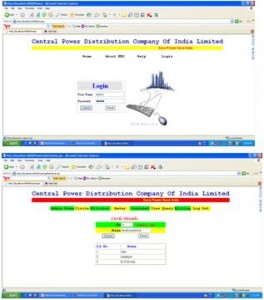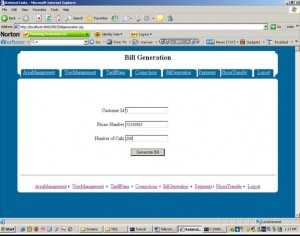The Power Billing System Project Report basically deals with the billing system. Since it’s a web application the problems of single tier could be solved using this application. Customers can lodge a complaint or deal with new connections just by logging into the system.
The application basically starts by asking the user to sign in by choosing the CIRCLE ID and ERO ID. Later username and password of the employee option is provided. Validating the username and password, the user is directed to the homepage were in he has various options like consumer management, revenue collection, billing and accounting, generating the report. Regarding the modification, constraint is provided wherein the access is limited to the administrator. The statuses of the requests are updated at the earliest. The rectification information will be again updated for the knowledge of the employee. The employee can check the status of the requests before accessing the computer, which will speed up the disposal of the request. Thus, improving the overall efficiency of the organization.
Scope:
This application is basically written as a solution to the drawbacks of existing system. This application can be used as a real world application and by any organization. It’s could be used as a general application with few minor modifications.
Purpose:
The purpose of this application is to develop “EBS” (Electronic Billing System), which is a web application which provides a service to all the customers and employees of A.P.S.E.B to deal with the transactions online.
The company is presently dealing with the transactions using Oracle. The problem with D2K is that there exists heavy network traffic either in two tier or three tier architecture. Here the cost to develop the project will be less but the reliability will be degraded. Thus this application provides a solution to problems of single tier. Customers can lodge a complaint or deal with new connections just by logging into the system and do the transactions online.
 Problem & Existing technology:
Problem & Existing technology:
In the traditional system files were used to maintain the database which was done manually. This existing system consumes a lot of time. This time consuming evaluation coupled by the huge maintenance problem and may also lead to erroneous results. The various operations performed on these files like sorting, adding, modifying and deletion of the records are very tedious. Moreover these manually maintained files have the possibility of getting worn out. Thus, less durability is achieved.
Thus the demerits of the existing system can be summarized as follows…
- There is no consistency as the data may not be updated on time.
- Feasibility is reduced
- Less reliability
- Security is not provided and any one can access
- Prioritization of records is difficult.
- More erroneous
- Difficult to maintain
- As every thing is done manually its slow process
- No timely acknowledgement service
Taking the demerits into consideration, an alternative system which uses Oracle as both front end and back end was used. In front end, retrieval of the data from the database is done through SQL queries i.e using D2K forms. This is not a web application and the data is not distributed as only a single system is used. As it is confined only to a particular system, scope is limited and there is a hindrance to the reliability if the system fails.
The demerits of this alternate system are…
- Only single system used.
- If the system crashes then the data is lost
- too overburdened
- not reliable
- slow processing
- less flexible
- not so user friendly
Proposed system
The proposed system is developed based on the client server architecture, a request-response paradigm and is implemented with the help of advanced java using the tomcat web container. The employees can maintain and do the transactions online.
The application starts by asking for user name and password which provides authentication. This system provides high security where the unauthorized users cannot access the data.
Later we have different options for the employee like
- Consumer Management
- Revenue Collection
- Billing and Accounting
- Reports
- Meter Details
- Ledger Process
- Journal Details
The objectives of the proposed system are as follows:
- Easy to use, effective and efficient
- Accurate results.
- Easy maintenance.
- Fast access
- More feasibility
- More secure.
- Provides high consistency.
- More reliable


